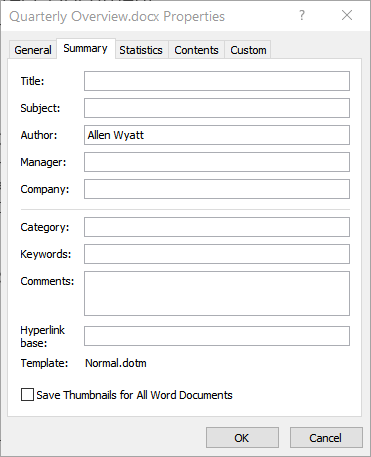Please Note: This article is written for users of the following Microsoft Word versions: 2007, 2010, 2013, 2016, 2019, and 2021. If you are using an earlier version (Word 2003 or earlier), this tip may not work for you. For a version of this tip written specifically for earlier versions of Word, click here: Using a Standard Format in a Suggested File Name.
Written by Allen Wyatt (last updated August 29, 2020)
This tip applies to Word 2007, 2010, 2013, 2016, 2019, and 2021
Richard asked if there was a way to modify the Word-generated file name that is suggested when you choose Save As or, in the case of a brand-new document, click the Save tool. He wants to suggest a standard file name that contains the date as the prefix for that name.
There are actually two different concepts at work here, depending on whether you are working on a new document or an existing document. If you are working with an existing document, then the file name suggested when you click on Save As is actually the document's current file name.
If you are working with a new document, then there is no functional difference between choosing Save or Save As; they both pull up the Save As dialog box. In this case, the suggested file name is based on the setting of the Title field in the Properties dialog box. If there is nothing in the Title field, then the suggested title is based on the first line of text in the file, up to the first punctuation mark.
Given the way that Word comes up with the suggested names, there are a couple things that can be done to utilize a standard. The first is to modify the template used for the documents, so that the Title field is set in it. For instance, follow these steps:

Figure 1. The Summary tab of the Properties dialog box.
Now, whenever you open a document based on that template, the Title field will already be set. When someone first saves the document, the title you entered in step 4 is suggested. This will spur the user to replace "yyyymmdd" with the proper date and replace "Title" with the real title.
If you want something more automatic—perhaps where the date is automatically filled in—then you need to rely on a macro. You essentially need to create a macro that replaces the Save and Save As commands and fills in the suggested file name as you want it done. Information on how to intercept various commands (such as Save and Save As) can be found at the Word MVP Web site:
https://wordmvp.com/FAQs/MacrosVBA/InterceptSavePrint.htm
In the macro you create, you can set the desired name before showing the File Save As dialog box. For instance, this snippet of code will handle the trick:
Dim sDefaultFileName as String
sDefaultFileName = "MyPaper"
With Application.Dialogs(wdDialogFileSaveAs)
.Name = sDefaultFileName
.Format = 0 '2 = Plain Text, 0 = Word Doc
If .Show = 0 Then 'User did not save
End If
End With
Remember that this code needs to be placed within a larger macro that you develop as a replacement for the Save As command. The .Show method is what actually displays the dialog box.
Note:
WordTips is your source for cost-effective Microsoft Word training. (Microsoft Word is the most popular word processing software in the world.) This tip (13283) applies to Microsoft Word 2007, 2010, 2013, 2016, 2019, and 2021. You can find a version of this tip for the older menu interface of Word here: Using a Standard Format in a Suggested File Name.

Discover the Power of Microsoft Office This beginner-friendly guide reveals the expert tips and strategies you need to skyrocket your productivity and use Office 365 like a pro. Mastering software like Word, Excel, and PowerPoint is essential to be more efficient and advance your career. Simple lessons guide you through every step, providing the knowledge you need to get started. Check out Microsoft Office 365 For Beginners today!
When working on a document, you most often want to save your edits using the existing name of the document. If Word ...
Discover MoreAfter using Word for a while, you may notice some "litter" of unused files on your hard drive. This tip explains how ...
Discover MoreWhen writing a macro that processes a text file, you may need to know when the end of the file has been reached. This is ...
Discover MoreFREE SERVICE: Get tips like this every week in WordTips, a free productivity newsletter. Enter your address and click "Subscribe."
2020-09-16 04:57:52
Richard
I discovered this feature of the title property when creating a PDF from a Word document, and then viewing that in Adobe Reader. I couldn't understand why the PDF filename was showing as 'word template 1625', until I realised that the template author had preloaded the title property.
2020-09-01 08:04:53
Simon Jones
As well as putting a default/prompt string into the Title property, I make templates for things like Reports, etc which have the Title property shown as a Building Block on the first page of the Report and in the Header. This makes it even easier for the user to name the document correctly, as they are just typing in the right place on the first page.
Got a version of Word that uses the ribbon interface (Word 2007 or later)? This site is for you! If you use an earlier version of Word, visit our WordTips site focusing on the menu interface.
Visit the WordTips channel on YouTube
FREE SERVICE: Get tips like this every week in WordTips, a free productivity newsletter. Enter your address and click "Subscribe."
Copyright © 2025 Sharon Parq Associates, Inc.
Comments